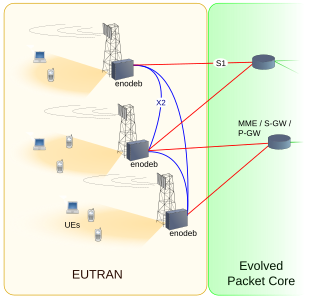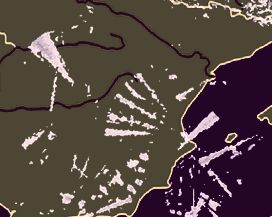
Code-division multiple access (CDMA) is a channel access method used by various radio communication technologies. CDMA is an example of multiple access, where several transmitters can send information simultaneously over a single communication channel. This allows several users to share a band of frequencies. To permit this without undue interference between the users, CDMA employs spread spectrum technology and a special coding scheme.

Digital enhanced cordless telecommunications (Digital European cordless telecommunications), usually known by the acronym DECT, is a standard primarily used for creating cordless telephone systems. It originated in Europe, where it is the common standard, replacing earlier cordless phone standards, such as 900 MHz CT1 and CT2.

Time-division multiple access (TDMA) is a channel access method for shared-medium networks. It allows several users to share the same frequency channel by dividing the signal into different time slots. The users transmit in rapid succession, one after the other, each using its own time slot. This allows multiple stations to share the same transmission medium while using only a part of its channel capacity. Dynamic TDMA is a TDMA variant that dynamically reserves a variable number of time slots in each frame to variable bit-rate data streams, based on the traffic demand of each data stream.
In telecommunications and computer networks, a channel access method or multiple access method allows more than two terminals connected to the same transmission medium to transmit over it and to share its capacity. Examples of shared physical media are wireless networks, bus networks, ring networks and point-to-point links operating in half-duplex mode.
Frequency-division multiple access (FDMA) is a channel access method used in some multiple-access protocols. FDMA allows multiple users to send data through a single communication channel, such as a coaxial cable or microwave beam, by dividing the bandwidth of the channel into separate non-overlapping frequency sub-channels and allocating each sub-channel to a separate user. Users can send data through a subchannel by modulating it on a carrier wave at the subchannel's frequency. It is used in satellite communication systems and telephone trunklines.

Worldwide Interoperability for Microwave Access (WiMAX) is a family of wireless broadband communication standards based on the IEEE 802.16 set of standards, which provide physical layer (PHY) and media access control (MAC) options.
4G is the fourth generation of broadband cellular network technology, succeeding 3G and preceding 5G. A 4G system must provide capabilities defined by ITU in IMT Advanced. Potential and current applications include amended mobile web access, IP telephony, gaming services, high-definition mobile TV, video conferencing, and 3D television.

A cellular network or mobile network is a telecommunications network where the link to and from end nodes is wireless and the network is distributed over land areas called cells, each served by at least one fixed-location transceiver. These base stations provide the cell with the network coverage which can be used for transmission of voice, data, and other types of content. A cell typically uses a different set of frequencies from neighboring cells, to avoid interference and provide guaranteed service quality within each cell.
This article discusses the mobile cellular network aspect of teletraffic measurements. Mobile radio networks have traffic issues that do not arise in connection with the fixed line PSTN. Important aspects of cellular traffic include: quality of service targets, traffic capacity and cell size, spectral efficiency and sectorization, traffic capacity versus coverage, and channel holding time analysis.
Spectral efficiency, spectrum efficiency or bandwidth efficiency refers to the information rate that can be transmitted over a given bandwidth in a specific communication system. It is a measure of how efficiently a limited frequency spectrum is utilized by the physical layer protocol, and sometimes by the medium access control.

Statistical multiplexing is a type of communication link sharing, very similar to dynamic bandwidth allocation (DBA). In statistical multiplexing, a communication channel is divided into an arbitrary number of variable bitrate digital channels or data streams. The link sharing is adapted to the instantaneous traffic demands of the data streams that are transferred over each channel. This is an alternative to creating a fixed sharing of a link, such as in general time division multiplexing (TDM) and frequency division multiplexing (FDM). When performed correctly, statistical multiplexing can provide a link utilization improvement, called the statistical multiplexing gain.

Orthogonal frequency-division multiple access (OFDMA) is a multi-user version of the popular orthogonal frequency-division multiplexing (OFDM) digital modulation scheme. Multiple access is achieved in OFDMA by assigning subsets of subcarriers to individual users. This allows simultaneous low-data-rate transmission from several users.
The Unlicensed National Information Infrastructure (U-NII) radio band, as defined by the United States Federal Communications Commission, is part of the radio frequency spectrum used by WLAN devices and by many wireless ISPs.

E-UTRA is the air interface of 3rd Generation Partnership Project (3GPP) Long Term Evolution (LTE) upgrade path for mobile networks. It is an acronym for Evolved UMTS Terrestrial Radio Access, also known as the Evolved Universal Terrestrial Radio Access in early drafts of the 3GPP LTE specification. E-UTRAN is the combination of E-UTRA, user equipment (UE), and a Node B.
Maximum throughput scheduling is a procedure for scheduling data packets in a packet-switched best-effort network, typically a wireless network, in view to maximize the total throughput of the network, or the system spectral efficiency in a wireless network. This is achieved by giving scheduling priority to the least "expensive" data flows in terms of consumed network resources per transferred amount of information.

This is a comparison of standards of mobile phones. A new generation of cellular standards has appeared approximately every tenth year since 1G systems were introduced in 1979 and the early to mid-1980s.
Dynamic Single Frequency Networks (DSFN) is a transmitter macrodiversity technique for OFDM based cellular networks.
Single-carrier FDMA (SC-FDMA) is a frequency-division multiple access scheme. It is also called linearly precoded OFDMA (LP-OFDMA). Like other multiple access schemes, it deals with the assignment of multiple users to a shared communication resource. SC-FDMA can be interpreted as a linearly precoded OFDMA scheme, in the sense that it has an additional DFT processing step preceding the conventional OFDMA processing.

Dynamic Frequency Selection (DFS) is a channel allocation scheme specified for wireless LAN, commonly known as Wi-Fi. It is designed to prevent electromagnetic interference by avoiding co-channel operation with systems that predated Wi-Fi, such as military radar, satellite communication, and weather radar, and also to provide on aggregate a near-uniform loading of the spectrum. It was standardized in 2003 as part of IEEE 802.11h.
Radio resource management (RRM) is the system level management of co-channel interference, radio resources, and other radio transmission characteristics in wireless communication systems, for example cellular networks, wireless local area networks, wireless sensor systems, and radio broadcasting networks. RRM involves strategies and algorithms for controlling parameters such as transmit power, user allocation, beamforming, data rates, handover criteria, modulation scheme, error coding scheme, etc. The objective is to utilize the limited radio-frequency spectrum resources and radio network infrastructure as efficiently as possible.







